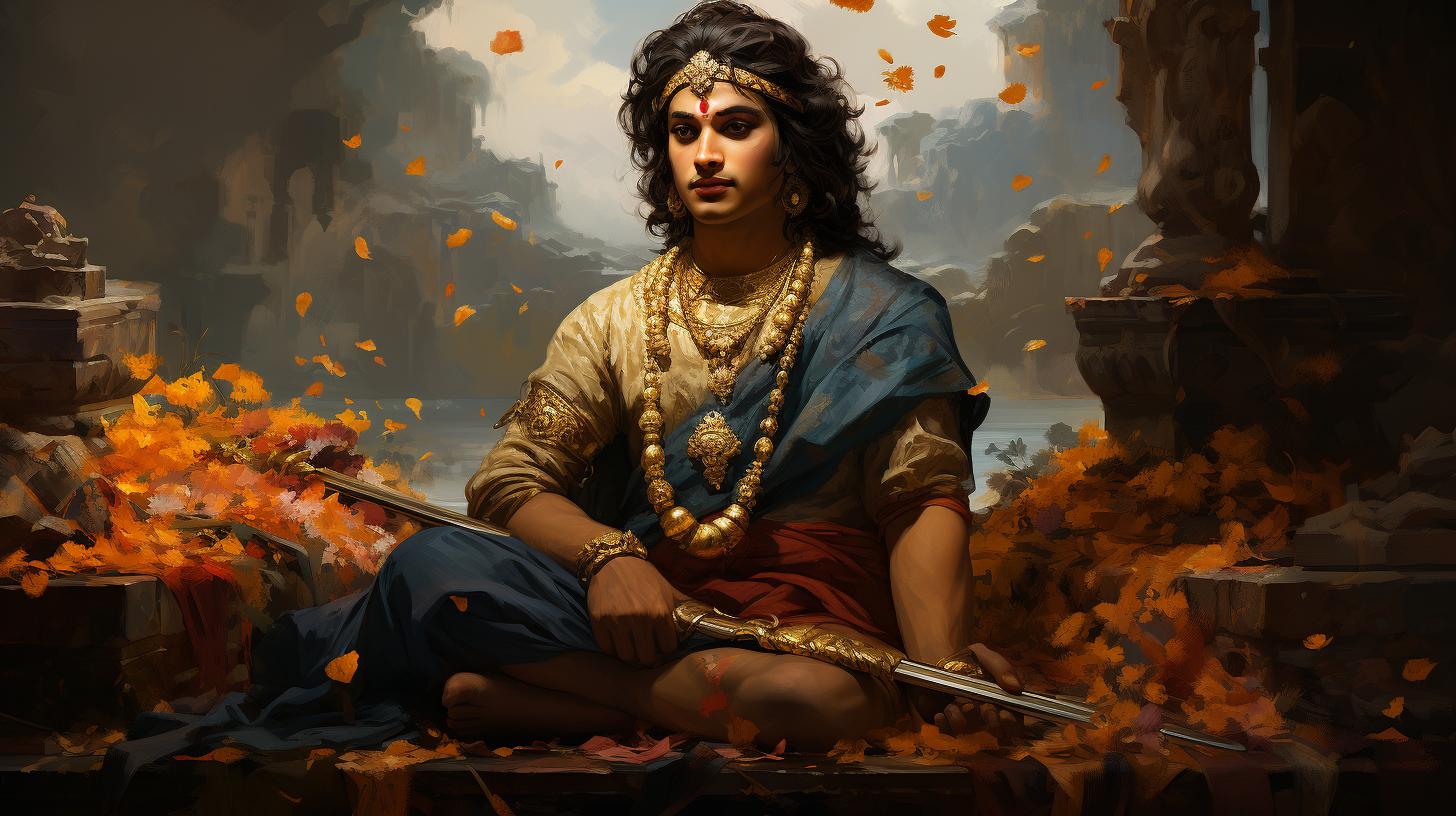Indian Goddess Saraswati Story: A Tale of Wisdom and Art

The Indian goddess Saraswati is a revered figure in Hindu mythology, representing knowledge, art, and wisdom. She is known as the spouse of Brahma and in some traditions, the first wife of Vishnu. Saraswati is depicted as a graceful deity with four arms, holding symbolic objects like a book, a rosary, a water pot, and a musical instrument called veena.
Her worship is celebrated during festivals like Saraswati Puja and Basant Panchami, where she is associated with the color yellow. Join us on a journey to explore the captivating story of the Indian goddess Saraswati.
Overview of Indian Goddess Saraswati
Indian Goddess Saraswati, a prominent figure in Hindu mythology, embodies knowledge, art, and wisdom. This overview explores the various aspects of Saraswati’s significance and her place within Hindu culture and rituals.
Hindu Mythology and Deities
In Hinduism, mythology plays a crucial role in shaping religious beliefs and practices. Hindu deities, such as Saraswati, hold immense significance and are revered for their unique attributes and roles within the pantheon.
The Role of Saraswati in Hinduism
Saraswati, known as the goddess of knowledge and learning, occupies a vital position in Hindu religious traditions. She represents the pursuit of wisdom, music, speech, and arts, making her an essential figure in the Hindu cosmology.
Saraswati as the Goddess of Knowledge and Learning
As the embodiment of knowledge and learning, Saraswati holds immense importance in the realm of education and academia. Hindu students and scholars often seek her blessings to attain wisdom, academic success, and creative inspiration.
Saraswati’s Relationships with Brahma and Vishnu
Saraswati is believed to be the wife of Brahma, the Hindu god associated with creation and knowledge. In some traditions, she is also regarded as the first wife of Vishnu, another prominent deity.
These divine relationships further enhance her significance within Hindu mythology.
Explore the fascinating iconography, symbolism, festivals, and cultural impact revolving around the revered Indian goddess Saraswati. Her influence transcends boundaries and continues to inspire devotees around the world.
Origin and Mythology of Saraswati
Originating from Hindu mythology, the goddess Saraswati holds a significant role in the religious and cultural beliefs of India. She is revered as the epitome of knowledge, learning, and wisdom. Let’s delve into the captivating origins and rich mythology surrounding Saraswati.
The Role of Saraswati in Hinduism
Saraswati occupies a prominent position among the pantheon of Hindu deities. She is regarded as the divine embodiment of intellectual pursuits, creativity, and eloquence. As the goddess of knowledge, Saraswati inspires individuals to seek wisdom and pursue education.
Saraswati as the Goddess of Knowledge and Learning
Saraswati’s association with knowledge and learning extends beyond academic pursuits. She symbolizes the deeper understanding of the self, spiritual enlightenment, and the cultivation of arts, music, and literature. Devotees turn to Saraswati for guidance and inspiration in their quest for intellectual growth and self-realization.
Saraswati’s Relationships with Brahma and Vishnu
Saraswati’s connection with the divine is intricately linked to her relationships with the gods Brahma and Vishnu. According to mythology, she is depicted as the wife of Brahma, the supreme creator in Hinduism.
Brahma represents the origin of existence, and Saraswati complements his creative powers with her role as the bestower of knowledge and wisdom.
Interestingly, in some traditions, Saraswati is also considered the first wife of Vishnu, the preserver of the universe.
This connection brings forth the concept of Saraswati’s role in nurturing and preserving knowledge throughout the cycles of creation and destruction.
Through the intertwined narratives of Saraswati’s origin, her embodiment of knowledge and learning, and her relationships with Brahma and Vishnu, the significance of the goddess in Hindu mythology becomes evident.
Saraswati serves as a source of inspiration for seekers of wisdom, fostering intellectual growth and creativity in the hearts of devotees.
Iconography and Symbolism of Saraswati
Saraswati, the Indian goddess of knowledge and art, is depicted in various art forms and sculptures that beautifully capture her essence and significance. The iconography of Saraswati showcases her divine attributes and symbolic representations, deepening our understanding of her role in Hindu mythology.
Depictions of Saraswati in Art and Sculpture
In Hindu art, Saraswati is portrayed as an elegant deity adorned with traditional attire and jewelry. Artists often depict her seated on a lotus flower, which symbolizes purity and spiritual awakening.
Her four arms convey her multi-dimensional nature, symbolizing her ability to bestow blessings and divine grace. Through meticulously crafted sculptures and paintings, Saraswati comes to life, captivating the viewer with her grace and wisdom.
Symbolic Attributes and Representations of Saraswati
Each aspect of Saraswati’s iconography carries profound symbolism. The book she holds signifies knowledge and education, emphasizing her status as the goddess of learning. The rosary represents the power of meditation and spiritual discipline.
The water pot symbolizes the purity of speech and the divine flow of wisdom. Lastly, the veena, the musical instrument she holds, signifies the harmonious blend of knowledge and art.
Through these symbolic attributes and representations, Saraswati represents the fusion of intellectual pursuits and artistic expression, reminding us of the inseparable nature of knowledge and creativity.
Immerse yourself in the art and sculptures dedicated to Saraswati, and you will gain a deeper appreciation for the profound symbolism associated with this revered Hindu goddess.
Festivals and Rituals Dedicated to Saraswati
Explore the vibrant festivals and rituals dedicated to the worship of Saraswati, the Indian goddess of knowledge and art.
Saraswati Puja: Worship and Celebration
Saraswati Puja is a significant festival celebrated to honor the goddess Saraswati. It is observed with great devotion and enthusiasm, particularly in educational institutions and households. People gather to offer prayers and seek her blessings for wisdom, knowledge, and success in academics and creative endeavors.
During Saraswati Puja, devotees set up elaborately decorated altars adorned with flowers and fruits. They dress in traditional attire and chant hymns to invoke the goddess’s presence. Offerings of fruits, sweets, and traditional dishes are made as a symbol of gratitude and respect.
Students place their books and musical instruments at the feet of the deity as a gesture of seeking her blessings for their educational pursuits.
This festival is also a platform for showcasing artistic talent.
Cultural programs, music and dance performances, and recitation of poems and hymns dedicated to Saraswati are organized. Students and artists present their skills as an offering to the goddess, creating an atmosphere of celebration and devotion.
Basant Panchami: Significance and Traditions
Basant Panchami, also known as Vasant Panchami, marks the arrival of spring and the onset of new beginnings. This festival holds special significance for devotees of Saraswati, as it celebrates the goddess’s association with learning and creativity.
On Basant Panchami, people dress in yellow attire, which is considered auspicious and represents the blossoming of nature. They offer prayers to Saraswati, seeking her blessings for wisdom, knowledge, and artistic pursuits.
Schools, colleges, and educational institutions organize special Saraswati Puja ceremonies, where students participate in traditional rituals and seek the goddess’s guidance for their academic journey.
One prominent tradition of Basant Panchami is the act of flying kites.
The sky is filled with colorful kites as people engage in friendly competitions, symbolizing the freedom of the mind and the spirit of joy associated with learning and creation. The sound of chanting, the music of the wind, and the vibrant hues of the kites fill the air, creating a festive atmosphere.
- Elaborately decorated altars with flowers and fruits
- Traditional attire and hymn chanting
- Offerings of fruits, sweets, and traditional dishes
- Placing books and musical instruments at the deity’s feet
- Cultural programs, music and dance performances
- Recitation of poems and hymns
- Dressing in yellow attire
- Offering prayers for wisdom and knowledge
- Flying kites as a symbol of freedom and joy
Join the festivities and experience the vibrant energy of Saraswati’s festivals.
Celebrate the power of knowledge, creativity, and the pursuit of wisdom bestowed by the revered goddess.
Cultural Significance of Saraswati
Saraswati, the Indian goddess of knowledge, holds a profound cultural significance in Indian society. She influences various aspects of Indian literature, music, education, and academics, fostering a deep connection with the pursuit of knowledge and artistic expression.
Saraswati’s Influence on Indian Literature and Music
In the realm of Indian literature, Saraswati’s presence is felt through her inspiration for poets, writers, and scholars. Many literary works pay homage to her, depicting her as the muse behind creativity and eloquence.
Her blessings are sought by those seeking wisdom and poetic skills.
Moreover, Indian classical music holds Saraswati in high regard. She is regarded as the patroness of music, symbolizing rhythm, melody, and harmony.
Musicians often invoke her blessings before performances, seeking her divine grace to enhance their musical abilities.
Saraswati in Education and Academics
Saraswati’s association with knowledge and learning extends to the field of education and academics. Students and teachers alike revere her as the embodiment of intelligence and wisdom. In educational institutions across India, Saraswati’s presence is acknowledged through special ceremonies and pujas (ritualistic worship) conducted to seek her blessings for academic success.
Additionally, Saraswati’s iconography can often be found in classrooms, libraries, and other educational spaces, serving as a constant reminder of the pursuit of knowledge. Many educational institutions and universities bear her name, further emphasizing her significance in the academic realm.
Overall, Saraswati’s cultural significance lies in her role as a catalyst for intellectual growth and artistic expression. Her influence permeates through Indian literature and music, inspiring creativity, while her association with education and academia solidifies her position as the divine patroness of knowledge.
Contemporary Worship and Devotion to Saraswati
The worship and devotion to the Indian goddess Saraswati continue to thrive in modern times. Saraswati temples and sacred sites dedicated to her are significant centers of reverence and spiritual practice across India and beyond.
These places draw devotees seeking blessings, knowledge, and inspiration from the goddess of wisdom and learning.
Temples and Sacred Sites Dedicated to Saraswati
Throughout India, numerous temples stand as an embodiment of devotion to Saraswati. These sacred sites serve as focal points for prayer, meditation, and communal gatherings. One such notable temple is the Saraswati Temple in Basar, Telangana, renowned for its architectural grandeur and spiritual ambiance.
Devotees flock to these temples to seek Saraswati’s blessings for academic success, artistic pursuits, and intellectual growth.
Other prominent Saraswati temples include the Koothanur Saraswathi Temple in Tamil Nadu, dedicated primarily to the goddess of music and arts, and the Pracheen Bharat Kala Kendra Temple in Chandigarh, which is an esteemed institution promoting Indian classical arts and culture.
Saraswati’s Role in Modern Hindu Practices
In addition to traditional rituals and temple worship, Saraswati’s influence extends to various aspects of modern Hindu practices. Many educational institutions in India hold Saraswati Puja and special events to honor the goddess at the beginning of the academic year.
Students seek Saraswati’s blessings to excel in their studies, gain knowledge, and hone their artistic talents.
Furthermore, Saraswati’s archetypal presence permeates the contemporary art scene, literature, and music in India. Artists, writers, and musicians often invoke Saraswati’s inspiration and guidance in their creative endeavors.
Her significance as the patroness of arts and learning is deeply ingrained in the cultural fabric of the nation.
Devotees also establish personal altars or shrines dedicated to Saraswati in their homes, where they offer prayers, perform rituals, and engage in quiet contemplation.
These private devotional spaces serve as a channel to connect with the goddess and seek her blessings for wisdom, intellect, and artistic expression.
The worship and devotion to the Indian goddess Saraswati continue to evolve and adapt in the modern era, reflecting the enduring relevance of her divine presence in the lives of people seeking knowledge, creativity, and spiritual enlightenment.
Saraswati Beyond India: Global Recognition and Influence
Saraswati, the Indian goddess of knowledge and art, extends her presence beyond the borders of India, finding recognition and influence in international Hindu communities worldwide. Her iconic status and revered archetype have transcended cultural boundaries, leaving an indelible impact on the global artistic landscape.
Saraswati’s Presence in International Hindu Communities
In diaspora communities around the world, Saraswati remains a vital figure in Hindu worship and cultural practices. As Hindus migrated to various regions, they brought along their religious beliefs, including reverence for Saraswati.
Temples dedicated to Saraswati have sprung up in countries such as the United States, Canada, the United Kingdom, and Australia, serving as spiritual hubs for Hindu communities.
These temples not only provide a place of worship but also serve as centers for cultural and educational activities.
They organize events and classes that celebrate Saraswati’s wisdom and encourage the pursuit of knowledge and artistic endeavors. Saraswati’s presence in these international Hindu communities helps maintain cultural connections while fostering the growth and preservation of traditional practices.
Impact of Saraswati’s Archetype in the Global Artistic Landscape
The archetype of Saraswati has permeated the global artistic landscape, inspiring artists, musicians, and writers from diverse backgrounds. Her association with knowledge, music, and creativity resonates with individuals seeking inspiration and expressing themselves through various art forms.
Across the world, Saraswati’s influence can be seen in the visual arts, with depictions of the goddess appearing in paintings, sculptures, and digital artworks. Her graceful form and symbolic attributes have become a muse for artists, capturing her essence in vibrant colors and intricate details.
In music, Saraswati’s significance is reflected in compositions dedicated to her and the presence of musical instruments associated with her, such as the veena. Musicians draw inspiration from Saraswati’s divine connection with melody and rhythm, infusing their compositions with her essence.
The literary world also pays homage to Saraswati, with authors incorporating her symbolism and characteristics into their works. Her embodiment of wisdom and the pursuit of knowledge serves as a source of inspiration for stories, poetry, and philosophical discourses.
- The visual arts, music, and literature bear witness to Saraswati’s far-reaching influence on humanity’s creative endeavors.
- Her universal themes of knowledge, art, and wisdom transcend cultural barriers and speak to the innate human desire for self-expression and growth.
- Saraswati’s archetype continues to inspire and shape the global artistic landscape, reaffirming the enduring power of her presence beyond the borders of India.
.




















